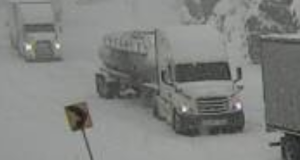 Red Pine Exploration Inc. is pleased to announce initial results of its near-surface drilling program focused on evaluating the potential of an open pit operation in two areas of the Jubilee Shear (See press release announced May 8, 2025). This drilling is a portion of the ongoing, fully funded 25,000 metres (“m”) drill program at the Wawa Gold Project, Ontario.
Red Pine Exploration Inc. is pleased to announce initial results of its near-surface drilling program focused on evaluating the potential of an open pit operation in two areas of the Jubilee Shear (See press release announced May 8, 2025). This drilling is a portion of the ongoing, fully funded 25,000 metres (“m”) drill program at the Wawa Gold Project, Ontario.
Highlights
- Near-surface intersection of 14.51 grams per tonne (“g/t”) gold (“Au”) over 4.81 m, including 90.40 g/t Au over 0.67 m, at the edge of the 2024 Mineral Resource Estimate1 (the “2024 MRE”) within an area for consideration for a potential open-pit operation;
- More than 14 drill holes are ongoing in the shallow part of the Jubilee Shear with results pending;
- Several high-grade gold intersections > 5.00 g/t Au at depth in the Jubilee Shear located hundreds of meters away from the 2024 MRE, are indicative of the potential for future growth to the mineral resource.
- Drilling at depth continues to identify key geological vectors towards potential zones of strong gold mineralization in the Jubilee Shear:
- Includes the identification of a new gabbro dyke interpreted to represent a key geological control on the Jubilee Shear at depths similar to the gabbro dykes controlling the distribution of gold mineralization near surface; and
- Outlines new exploration targets at depths in the Jubilee Shear in the Cooper Mine area.
- The focus of the drilling is to build out the near surface resource to complete an updated MRE and a Preliminary Economic Assessment by H1 2026.
Michael Michaud, President and CEO of Red Pine commented: “We are excited that our initial near-surface drilling has already intersected wide zones of alteration, quartz veining and significant gold grades. This drilling is designed to not only improve our confidence in the gold distribution, but also to expand gold mineralization in this relatively underexplored area. This drilling is the first step in assessing the potential of a near-term open pit operation that would provide an incremental approach to move towards a larger operation to mine the existing open-pit and underground mineral resource base outlined in the 2024 MRE.
We are also pleased with the positive results from deeper drilling as we continue to gain more knowledge on the geology and the potential to intersect gold mineralization in large step-outs from the 2024 MRE. Of importance, we have now intersected a gabbro unit at depth that is known to be a critical control on mineralization as identified closer to surface where we have already defined a large open-pit and underground resource.
The Company intends to update the 2024 MRE with the completion of the drilling program, with the objective to concurrently work towards a preliminary economic assessment (“PEA”), anticipated for completion in H1 2026.”
1The MRE is described in the National Instrument 43-101 Technical Report dated September 30, 2024 (with a mineral resource effective date of August 28, 2024) entitled “National Instrument 43-101 Technical Report for the Wawa Gold Project” (the “2024 Technical Report”).
Ongoing Drilling Program
Red Pine is currently drilling with 2 rigs and completed approximately 65% of the fully funded 25,000 m exploration program. The ongoing drilling at depth continues to intersect gold mineralization with large step outs designed to expand the mineral resource base. In parallel, near-surface testing of the Jubilee Shear has started in two areas identified as having high potential for open-pits within the near-surface portion of the 2024 MRE.
The near-surface drilling program consists of closely spaced drill holes aiming to increase confidence in the 2024 MRE and extend gold mineralization within the crown pillar of the former Surluga and Jubilee mines where historic drilling was limited. Between 8,000 and 9,000 m of drilling is allocated to evaluate the two areas and is expected to take 3 months to complete.
Near-Surface Drill Testing of the Jubilee Shear for Potential Open-Pit Operation (Tables 1 and 2 and Figures 1 to 3):
In addition to the strong results obtained in SD-25-552, previous drilling supports the potential of the areas considered for potential open-pits (Figure 1). Significant historical results included in the 2024 MRE in each area include:
- Northern Area
- 4.40 g/t Au over 9.61 m, including 38.74 g/t Au over 0.77 m and 28.80 g/t Au over 0.31 m in historical drill hole S073
- 13.24 g/t Au over 4.69 m, including 18.64 g/t Au over 3.17 m in historical drill hole S063
- Jubilee Mine Area
- 4.42 g/t Au over 18.99 m, including 40.20 g/t Au over 1.00 m in SD-17-172
- 9.62 g/t Au over 14.93 m, including 12.47 g/t Au over 1.83 m, 24.14 g/t Au over 0.91 m and 81.12 g/t Au over 0.91 m in historical drill hole S240
Jubilee Deep Drilling (Tables 1 and 2 and Figure 2):
Deep drilling in the Jubilee Shear that consists of large step-outs from the 2024 MRE, continues to uncover indications of high-grade gold mineralization at depth and is vectoring towards new zones of high-grade gold mineralization. Additional drill testing of the deeper extension of the Jubilee Shear is planned to continue in parallel with the drill testing of the near-surface extension of the Jubilee Shear.
Key highlights of the deep drilling in the Jubilee Shear include:
- Multiple intersections greater than 5.00 g/t Au indicating that mineralization extends beyond the 2024 MRE (including the drilling results announced on February 19 and March 20, 2025):
- Additional drilling will be necessary to infill the gaps between the widely spaced drill holes completed to date to find areas of thickening of the high-grade core of the Jubilee Shear.
- Identification of a new gabbro dyke at depth west of the Jubilee Shear in relation to the roll discussed in the February 19 and March 20, 2025 press releases:
- Wide gabbro intersections in SD-25-536 and SD-540 below the Main Deformation Zone of the Jubilee Shear interpreted to represent a new gabbro dyke
- In the shallower parts of the Jubilee Deposit, the main zones of mineralization forming the 2024 MRE are distributed above and below such gabbro dyke
- Gabbro dykes are a key geological control on the location of rolls which are areas where the dip of the shear zone changes that can correspond to zones of thickening of mineralization in the shears of the Wawa Gold Project
- Mineralogical transition from white-mica dominated to chloritized-biotite alteration haloes around the strongly deformed veins in the Jubilee Shear. In other deposits of the Michipicoten Greenstone Belt, that mineralogical transition is an indicator that the gold system is changing and that this can result in positive changes in the nature of the gold mineralization zones.
Table 1 Drilling results from the 2024-2025 drilling program
| Hole (#) |
From (m) |
To (m) |
Length (m)* |
Gold (g/t) |
Zone (name) |
| SD-25-533 | 658.88 | 659.68 | 0.80 | 2.24 | Jubilee Shear – Main |
| 672.00 | 673.09 | 1.09 | 5.01 | ||
| SD-25-535 | 211.46 | 213.00 | 1.54 | 7.23 | Vein Network |
| SD-25-536A | 968.00 | 969.06 | 1.06 | 2.56 | Jubilee Shear – Main |
| SD-25-538 | 741.00 | 742.00 | 1.00 | 5.32 | Jubilee Shear – Upper |
| 788.32 | 798.31 | 9.99 | 1.95 | Jubilee Shear – Main | |
| including | 795.20 | 796.40 | 1.20 | 8.50 | |
| SD-25-539 | 93.80 | 95.56 | 1.76 | 3.00 | Mickelson Vein Network |
| 480.34 | 483.61 | 3.27 | 2.92 | Jubilee Shear – Main | |
| Including | 481.43 | 483.61 | 2.18 | 4.12 | |
| 643.50 | 644.78 | 1.28 | 3.96 | ||
| SD-25-552 | 64.64 | 69.45 | 4.81 | 14.51 | Jubilee Shear – Main |
| Including | 65.75 | 66.42 | 0.67 | 90.40 | |
| 67.27 | 68.12 | 0.85 | 7.93 |
*Intercepts are calculated using a 0.40 g/t Au cut-off and a maximum of 6.0 m of internal dilution with no capping applied and are reported over core lengths. True widths are estimated to vary between 70 to 95% of the reported core length in the Jubilee and undefined in the vein networks. The reported assay results represent 4,614.23 m of assayed core from the 2025 drilling program in the extension at depth of the Jubilee Shear and 16.88 m from near-surface drilling in the Northern Area for consideration for Phase 1 open-pits.
Quality Assurance/Quality Control (“QA/QC”) Measures
Individual drill core samples are labelled and split in half along a pre-marked cutting line using a diamond saw. A consistent half-core sample is then placed in an individual plastic sample bag that is sealed. The remaining half-core samples are kept at the core storage facility of the Company located on the Wawa Gold project. Quarter-core duplicates are taken from certain samples to define the variability of gold distribution. Groups of samples are then placed into durable rice bags sealed with security seals to be transported using a commercial carrier for analysis to Actlabs in Ancaster, Ontario. NQ core assays were obtained by 50-gram fire-assaying-AA finish or by 1-kilogram screen fire assay. The 1-kilogram screen assay method is selected for samples anticipated to contain coarse gold and when the fire-assay-AA finish return results greater or equal to 2.25 g/t Au. The residual coarse reject portions of the samples remain in storage for a minimum 90-day period if further work or verification is needed.
As part of its QA/QC program, Red Pine inserts external gold standards (low- to high-grade) and blanks every 20 samples and routinely insert blanks immediately after samples with visible gold. Quarter core duplicates are routinely inserted to evaluate the natural variability of gold mineralization. Assay certificates are sent to at least three members of the senior management team, and they are directly accessible from the WebLIMS portal of Actlabs. Approximately 5% of the pulps and coarse rejects analyzed at Actlabs are sent to Agat Laboratories in Thunder Bay for umpire testing.
Table 2 – Drill hole location
| Hole (#) |
UTM E (m) |
UTM N (m) |
Elevation (masl) |
Azimuth (°) |
Inclination (°) |
Length (m) |
Assays Status |
Area |
| SD-25-533 | 668713 | 5314807 | 346.0 | 303.0 | 60.1 | 873.0 | Complete | Jubilee Deep |
| SD-25-534A | 668713 | 5314807 | 346.0 | 303.0 | 60.1 | 1116.0 | Complete | Jubilee Deep |
| SD-25-535 | 668859 | 5315950 | 370.5 | 267.0 | 70.0 | 841.0 | Complete | Jubilee Deep |
| SD-25-536A | 668713 | 5314807 | 346.0 | 300.0 | 66.0 | 1149.0 | Complete | Jubilee Deep |
| SD-25-537 | 668859 | 5315950 | 370.5 | 300.0 | 65.3 | 785.0 | Complete | Jubilee Deep |
| SD-25-538 | 668708 | 5315808 | 370.0 | 218.0 | 73.1 | 858.0 | Complete | Jubilee Deep |
| SD-25-539 | 668582 | 5315801 | 368.5 | 323.0 | 70.9 | 696.0 | Complete | Jubilee Deep |
| SD-25-540 | 668922 | 5315725 | 353.3 | 240.0 | 70.4 | 1002.0 | Pending | Jubilee Deep |
| SD-25-541 | 668219 | 5317008 | 359.6 | 295.0 | 45.2 | 390.0 | Pending | Northern area |
| SD-25-542 | 668258 | 5317118 | 364.0 | 295.0 | 45.2 | 399.0 | Pending | Northern area |
| SD-25-543 | 668283 | 5317185 | 359.3 | 302.0 | 45.0 | 57.0 | Pending | Northern area |
| SD-25-544 | 668267 | 5317163 | 362.0 | 302.0 | 45.0 | 162.0 | Pending | Northern area |
| SD-25-545 | 668562 | 5315305 | 370.8 | 283.0 | 83.2 | 1033.0 | Pending | Jubilee Deep |
| SD-25-546 | 668233 | 5317053 | 363.9 | 295.0 | 49.2 | 150.0 | Pending | Northern area |
| SD-25-547 | 668289 | 5317260 | 346.6 | 290.0 | 47.3 | 126.0 | Pending | Northern area |
| SD-25-548 | 668328 | 5317385 | 371.3 | 290.0 | 45.2 | 264.0 | Pending | Northern area |
| SD-25-549 | 668363 | 5317459 | 375.1 | 290.0 | 45.0 | 135.0 | Pending | Northern area |
| SD-25-550 | 668362 | 5317460 | 375.3 | 290.0 | 45.0 | 135.0 | Pending | Northern area |
| SD-25-551 | 668362 | 5317460 | 375.3 | 290.0 | 89.1 | 132.0 | Pending | Northern area |
| SD-25-552 | 668331 | 5317415 | 373.8 | 290.0 | 45.2 | 135.0 | Partial | Northern area |
| SD-25-553 | 668331 | 5317415 | 373.8 | 290.0 | 70.1 | 141.0 | Pending | Northern area |
| SD-25-554 | 668331 | 5317415 | 373.8 | 110.0 | 85.0 | 132.0 | Pending | Northern area |
| SD-25-555 | 668344 | 5317441 | 374.9 | 290.0 | 45.0 | 148.0 | Pending | Northern area |
- Mixed Curling Standings – December 13 - December 13, 2025
- Ladies Curling Standings – December 12th - December 12, 2025
- Municipality of Wawa Partners with SECFDC to Administer Municipal Accommodation Funds - December 10, 2025
 Wawa-news.com You can't hear the 'big picture'!
Wawa-news.com You can't hear the 'big picture'!

